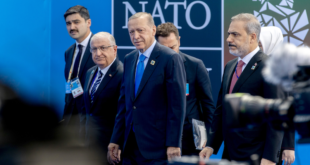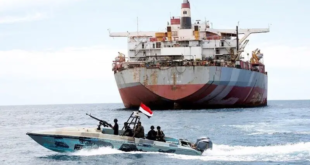The role of the United States in strengthening the eastern flank of NATO
The period after the end of the Cold War led to significant changes in the military-political sphere of Eastern Europe. Many of these changes were caused by the collapse of the Soviet Union, which led to the formation of independent states, for example, in the Baltics. NATO’s military presence in Eastern Europe has steadily increased since the late 1990s. and continues to grow today. Despite the end of the Cold War and the disappearance of the main threat to Western countries, this organization has not curtailed its activities, but, on the contrary, is expanding its sphere of interests at the expense of the former member countries of the Warsaw Pact Organization and the republics of the former USSR. After the annexation of Crimea by Russia in 2014 and the outbreak of hostilities in eastern Ukraine, the activity of the North Atlantic Alliance in Eastern Europe intensified even more.
According toNATO itself, Russia has again become the main threat to the security of the Allies, as well as to peace and stability in the Euro-Atlantic region. At the NATO Summit in Warsaw in 2016, in response to increased instability and insecurity on NATO’s periphery, Allied Heads of State and Government agreed to establish a forward NATO presence in the northeast and southeast of the Alliance. For example, in Estonia, Latvia, Lithuania and Poland, four multinational battlegroups were created in 2017, led by the United Kingdom, Canada, Germany and the United States, respectively. The naval presence in the Black Sea was also increased. In addition, NATO has increased its military budget, especially in the area of cyber defense. Besides, cooperation with Ukraine in carrying out reforms in the field of defense and combating corruption was intensified. In 2020, exercises were held “Defender Europe 20 “, which was the largest exercise in the last 25 years. The exercise focused on the rapid deployment of forces on Russia’s borders to show NATO’s readiness to protect its allies in the event of a conflict.
In addition, the Alliance has invested in improving infrastructure in Eastern Europe, building new military bases and upgrading airfields to improve its ability to respond to potential threats from Russia. The Ukrainian crisis has led to a renewed emphasis on collective defense within NATO.
The Alliance has increased its focus on collective defense planning and capacity building, as well as strengthening its partnerships with non-NATO countries in the region. In November 2022, an information bulletin was published on the composition of eight multinational battle groups with a total strength of more than 10,000 people who were deployed in Bulgaria, Estonia, Hungary, Latvia, Lithuania, Poland, Romania and Slovakia. In addition to changes in the military balance, a political transformation was also taking place in Eastern Europe, caused by the desire of the countries of the former socialist bloc to integrate into the institutions of the European Union.
Slovakia
Slovakia, along with Romania, Bulgaria and Poland, was a member of the Warsaw Pact in the 20th century. The demise of this organization allowed them to move towards integration with Western institutions such as NATO and the European Union. After gaining independence in 1993, Slovakia was not included in the first wave of NATO enlargement in 1999. Along with joining the EU, it became a full member of this organization only in 2004. Since then, NATO’s presence in Slovakia has gradually increased. Thus, joint military exercises are held on its territory, there are training programs and infrastructure development projects in order to increase military potential and interoperability. Slovakia took an active partin operations conducted by NATO: in the Balkans (as part of the IFOR, SFOR, KFOR forces), in Afghanistan and Iraq.
Units of the Slovak armed forces are involved in the NATO Response Force. In the North Atlantic Alliance itself, Slovakia was nameda key country in defending its eastern flank, and the created multinational battle group “Slovakia” consists of a thousand soldiers from the Czech Republic, Germany, Slovakia, Slovenia and the United States. An air and missile defense unit is currently deployed on its territory, formed from 500 military personnel from Germany, the Netherlands and the United States as part of the NATO air defense mission. They operate the Patriot missile defense capability in close coordination with the NATO Integrated Air and Missile Defense System (NATINAMDS) and support the Control and Reporting Center (CRC) in Zvolen. In addition, Slovakia hosts the NATO Force Integration Unit (NFIU), whose role is to facilitate the rapid deployment of additional forces in the region if necessary.
Baltic States
The Baltic states, consisting of Estonia, Latvia and Lithuania, have also undergone significant military and political transformations since the end of the Cold War. These countries joined the European Union in 2004. In the same year, Estonia, Latvia and Lithuania joined NATO. The Baltics are a key strategic region where the military and economic interests of the North Atlantic Treaty Organization and Russia intersect. To date, more than 5 thousand soldiers of the Alliance are concentrated there: 1373 people in Estonia (the basis is British), 1840 people in Latvia (the basis is Canadians), 1805 people in Lithuania (the basis is Germans). In 2022, the Baltic countries demandedfrom NATO to increase its presence and deploy additional combat groups on the territory of 3 states. In July of the same year, during the Madrid summit of NATO, a compromise formula “3 + 3” was adopted with the participation of Great Britain, Canada and Germany, according to which additional reserve forces could be deployed in the Baltic states as soon as possible.
This, according to the initiators of strengthening the eastern flank, is not enough, however, the local infrastructure of training grounds and barracks needs significant development. Thus, an additional build-up of forces in the Baltics is hampered by structural problems, and not only on the part of the host countries. Thus, at present and for the foreseeable future, the British Army is unable to maintain a permanent rotational presence of an entire armored brigade outside the UK without a mobilization call. Its 3rd division, intended for operations in the European theater of operations, will complete the process of restructuring and modernization only by 2030 and will consist of two armored battle groups and one reconnaissance and artillery brigades. That is why London cannot allocate a specific brigade to Estonia, and can offer only individual units. The German army will not have a single fully equipped brigade until 2023, when it will take over duty as part of the NATO Joint Task Force (VJTF). By 2027, the Bundeswehr will have only one fully modernized division at its disposal. Thus, by about 2026, it will be able to permanently deploy only one brigade in Lithuania on a rotational basis. Canada also faces the challenge of deploying an entire brigade without prior mobilization, as its peacetime military consists of only three mechanized brigades. By 2027, the Bundeswehr will have only one fully modernized division at its disposal. Thus, by about 2026, it will be able to permanently deploy only one brigade in Lithuania on a rotational basis. Canada also faces the challenge of deploying an entire brigade without prior mobilization, as its peacetime military consists of only three mechanized brigades. By 2027, the Bundeswehr will have only one fully modernized division at its disposal. Thus, by about 2026, it will be able to permanently deploy only one brigade in Lithuania on a rotational basis. Canada also faces the challenge of deploying an entire brigade without prior mobilization, as its peacetime military consists of only three mechanized brigades.
Poland
Poland joined NATO in 1999, which was a significant step towards the expansion of this organization in the East. Accession to the European Union was carried out after 5 years in 2004. Poland has regularly insisted on increasing the number of troops and military infrastructure of the North Atlantic Alliance on its territory as a deterrent against Russia. In 2015, NATO opened a command center in Poland ( NATO Force Integration Unit ), which has become one of the main centers for coordinating the actions of allies and members of the North Atlantic Alliance in the region. In 2017, the 2nd Armored Brigade of the 1st Infantry Division of the US Armed Forces was deployed to Poland. Poland made a deal in 2020in the amount of $4.6 billion to buy 32 F-35 fighter jets from the US, making it the first country in Eastern Europe to operate these combat aircraft. Since the same year, the advanced command of the Fifth Corps of the US Army has been operating in Poland.
In December 2022, as part of the 2014 Atlantic Resolve program to strengthen the US military presence in Europe, the United States deployed 700 combat vehicles to Poland, including M1A2 Abrams tanks, Bradley infantry fighting vehicles and M113 armored personnel carriers of the 1st Infantry Division of the Ground Forces. In early 2023, the shipment of US military equipment to Europe continued. So, about 1250 combat vehicles intended for deployment in Poland and Lithuania arrived in the Dutch port of Vlissingen in January. Among them are Abrams tanks and Bradley fighting vehicles of the 2nd Brigade Combat Team, 1st Cavalry Division from Fort Hood, Texas. At the end of March 2023, the first permanent US military garrison was opened in Poland., which became the eighth in Europe. Its main task is to coordinate and monitor US ground forces in Europe, operational planning, and cooperation and synchronization of US forces with those of other NATO countries. The forward command of the US Army Fifth Corps, operating in Poznan since 2020, has been named Camp Kościuszko (Camp Kosciuszko). In total, about 10 thousand military personnel of NATO countries are currently deployed in Poland, most of which are Americans.
Bulgaria and Romania
Bulgaria and Romania were among the USSR’s closest allies during the Cold War. After its completion, the countries radically changed their foreign policy vector and already in 2004, during the fifth wave of NATO expansion, they became full-fledged members of this organization. Accession to the EU took place 3 years later – in 2007. Integration into the North Atlantic Alliance and the European Union has led to changes in defense and security policy. Romania and Bulgaria have increased their defense spending and modernized their armed forces to NATO standards. Bulgaria participated in the fighting in Iraq and had its own contingent as part of the International Security Forces in Afghanistan (ISAF). ISAF has become the largest military mission in Bulgaria with an annual cost of $68.7 million. In 2022 Bulgariaapproved the deployment on its territory of the NATO battle group, consisting of 800 Italian troops. Also, the Bulgarian NATO battle group included a company from the Royal Irish Regiment of the British Army (120 people) and an American company of Stryker armored fighting vehicles. Romania’s direct participation in NATO activities began in August 2004. Bucharest joined the NATO mission to train the Iraqi security forces. Since October 2005, the Romanian Navy began to take part in the Active Endeavor operations in the Mediterranean. Romania hoststhe following NATO structures on their territory: the NATO Force Integration Unit (NFIU), the headquarters of the multinational division and the brigade “South-East”. Romania has played a role in the development of Ukraine’s cyber defense, being the coordinating state of the NATO-Ukraine Cyber Defense Fund in the first phase of the project, which ended in 2017.
Thus, the end of the Cold War and the fall of the bipolar world order radically changed the military-political situation in Eastern Europe. The collapse of the USSR and the weakening of Russia’s geopolitical positions allowed the United States to continue expanding NATO and draw into the orbit of influence almost all the new states that gained their independence in 1991, thereby reaching the Russian borders. The declaration of Russia in the new NATO strategy of 2022 as a direct threat to its members, as well as to peace and stability in the Euro-Atlantic region, will contribute to the further build-up of military potential in the countries of Eastern Europe, where Poland and the Baltic countries are the main initiators of strengthening this flank.
 Eurasia Press & News
Eurasia Press & News




